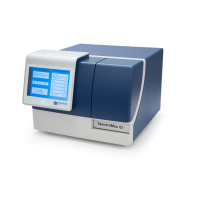SpectraMax iD3 Multi-Mode Microplate Reader User Guide
12 5054747 B
Users with the Sign Statements permission click GxPMode On to lock the
instrument touchscreen and operate the instrument from the computer running the
SoftMax Pro Software in GxP mode. This locks the instrument touchscreen for all users
and the instrument must be operated from a computer running SoftMax Pro GxP
Software.
Users with the Sign Statements permission click GxPMode Off to release the lock
from the instrument touchscreen and allow users to perform reads from the instrument.
Note: The instrument remains locked until the Sign Statements user clicks GxPMode
Off to stop the GxP mode. You cannot use the Instrument Connection dialog to
disconnect from an SpectraMax iD3 instrument that is locked in GxP mode.
The SpectraMax iD3 software version 1.0 is compatible with SoftMax Pro Software version
7.0.1.
The SpectraMax iD3 software version 1.1 is compatible with SoftMax Pro Software version
7.0.2.
To update the SpectraMax iD3 software, please contact Technical Support.
Applications
The high sensitivity and flexibility of the instrument make it useful for applications in the
fields of biochemistry, cell biology, immunology, molecular biology, and microbiology.
Typical applications include ELISA, nucleic acid, protein, enzymatic type homogeneous and
heterogeneous assays, microbial growth, endotoxin testing, and pipettor calibration.
Application notes with specific application protocol suggestions can be found in the
Information Center and the Knowledge Base on the Molecular Devices web site at
www.moleculardevices.com.
Optics
The 2x2 monochromators permit individual optimization of wavelengths for both excitation
and emission in fluorescence readings. Mirrored optics shape the light, and a height-
adjustable objective lens focuses the beam into the sample volume. PMT Gain can be set to
automatic, high, medium, or low.
Dynamic Range
The dynamic range of detection is approximately from 10
-6
to 10
-12
molar fluorescein.
Variations in measured fluorescence values are virtually eliminated by internal compensation
for detector sensitivity, photomultiplier tube voltage and sensitivity, and excitation intensity.
The photometric range is 0.000 to 4.000ODs with a resolution of 0.001OD.
CAUTION! Never touch the optic mirrors, lenses, filters, or cables. The optics are
extremely delicate, and critical to the function of the instrument.

